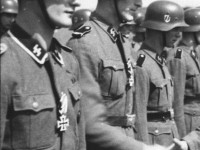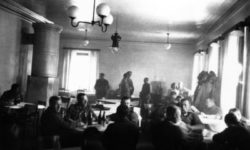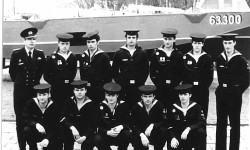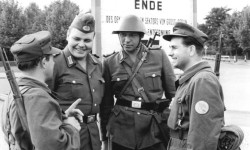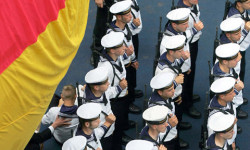SS candidates, also referred to as season candidates, were male persons who had applied for admission to the general SS or to the armed SS associations such as SS Totenkopfverbände or SS-Verfügungstruppe (from 1940 Waffen-SS). The membership in the NSDAP was not mandatory for the application, although most of the SS candidates belonged to it. In the Waffen-SS, the military rank SS-Sagittarius was used instead of the designation SS-Applicant / Staffeliver.
Admission criteria
As of September 1935, according to "Circular No. 1", applicants aged 23 to 35 years were admitted to the newly formed Schutzstaffel. They had to be able to name two guards, have been reported to a police station for five years, and also be healthy and well-built.
The most important prerequisite for a successful application was the small Aryan certificate, in which the applicant's complete Aryan, d. H. especially non-Jewish descent to his grandparents (for team grades and Unterführer ranks) had to prove. For leaders or leader candidates the Great Aryan evidence was required, which had to go back to 1750 without gaps.
For the admission of SS applicants in the Schutzstaffel were the then SS-Hauptsturmführer Professor dr. Bruno K. Schultz elaborated value scale for the race commission of the race and settlement main office (RuSHA), before which the SS-applicants had to appear to the entrance examination, compelling condition. The value scale contained three groups:
- racial appearance of the candidate
- physical condition
- general attitude
In addition, the so-called race table difference five groups:
- purely Nordic group
- predominantly Nordic or Falish group
- Group of one and two harmoniously mixed people with slight alpine, Dinaric or Mediterranean additions
- group of half-breeds of Eastern or Alpine origin
- group of Mischlinge of non-European origin
Only candidates who fulfilled the criteria of the first three groups were SS worthy. In addition, RuSHA professor Schultz called for a well-proportioned physique in a nine-point system. Here were only the first four notes ("ideal stature", "excellent", "very good" and "good") recording relevant. Applicants with the lowest three grades usually failed.
In addition to the "racial inclusion" of the candidates in one of the five groups, they also had to have a sporty-trained physique and a prescribed minimum size. This concerned only persons who wanted to join the SS after 1933. Old fighters of the SS were not bound by these minimum sizes.
After formally determining the eligibility of the race commission, the candidate had to undergo examinations and trials. The individual stations were based on the NS holiday calendar.
Crews
- SS-Schütze
- SS-Oberschütze
- SS-Sturmmann
- SS-Rottenführer
SS-Schütze (1), SS-Oberschütze (2), SS-Sturmmann (3), SS-Rottenführer (4)
Noncommissioned officers
- SS-Unterscharführer
- SS-Scharführer
- SS-Oberscharführer
- SS-Hauptscharführer
- SS-Sturmscharführer
SS-Unterscharführer (1), SS-Scharführer (2), SS-Oberscharführer (3), SS-Hauptscharführer (4), SS-Sturmscharführer (5)
In addition, there were in the ranks of the NCOs also the leaders candidate ranks, comparable to the cadets in the Wehrmacht:
- SS-Junker
- SS-Oberjunker
- SS-Standartenjunker
- SS-Standartenoberjunker
Officers
- SS-Untersturmführer
- SS-Obersturmführer
- SS-Hauptsturmführer
- SS-Sturmbannführer
- SS-Obersturmbannführer
- SS-Standartenführer
- SS-Oberführer
SS-Untersturmführer (1), SS-Obersturmführer (2), SS-Hauptsturmführer (3), SS-Sturmbannführer (4), SS-Obersturmbannführer (5),
SS-Standartenführer (6), SS-Oberführer (7)
Generals
- SS-Brigadeführer
- SS-Gruppenführer
- SS-Obergruppenführer
- SS-Oberst-Gruppenführer
- Reichsführer-SS (Heinrich Himmler)
SS-Brigadeführer (1), SS-Gruppenführer (2), SS-Obergruppenführer (3), SS-Oberst-Gruppenführer (4),
Reichsführer-SS (Heinrich Himmler) (5)
You can find the right literature here:
The Waffen-SS: A European History
This is the first systematic pan-European study of the hundreds of thousands of non-Germans who fought - either voluntarily or under different kinds of pressures - for the Waffen-SS (or auxiliary police formations operating in the occupied East). Building on the findings of regional studies by other scholars - many of them included in this volume - The Waffen-SS aims to arrive at a fuller picture of those non-German citizens (from Eastern as well as Western Europe) who served under the SS flag. Where did the non-Germans in the SS come from (socially, geographically, and culturally)? What motivated them? What do we know about the practicalities of international collaboration in war and genocide, in terms of everyday life, language, and ideological training? Did a common transnational identity emerge as a result of shared ideological convictions or experiences of extreme violence? In order to address these questions (and others), The Waffen-SS adopts an approach that does justice to the complexity of the subject, adding a more nuanced, empirically sound understanding of collaboration in Europe during World War II, while also seeking to push the methodological boundaries of the historiographical genre of perpetrator studies by adopting a transnational approach.
Waffen-SS: Hitler's Elite in Photographs
From their humble beginnings as a small, select band responsible for protecting the leader of the Nazi Party, to its million members and 38 divisions by the end of World War II, the SS achieved some of the most stunning victories in the annals of warfare, while also committing a catalogue of war crimes. Including 500 photographs, many seldom seen outside the personal archives of former soldiers, Waffen-SS: Hitler’s Elite in Photographs contains all the battles and campaigns that the Waffen-SS fought, including Poland, France and on the Eastern Front. The book charts the growth of the Panzer divisions, their battlefield tactics, recruitment and organization of units, and an examination of the weapons and equipment. Leading figures, such as ‘Sepp’ Dietrich, Felix Steiner and Joachim Peiper, are also featured. But the Waffen-SS were not just highly-trained troops. From the beginning the black-uniformed men of the armed Schutzstaffel (Protection Squad) were ideological warriors, selected on the basis of rigid racial and physical standards, who viewed with contempt the members of those races classed by National Socialist ideology as being sub-human. This book does not shy away from their atrocities. Waffen-SS: Hitler’s Elite in Photographs is a full pictorial record of the development, combat actions and criminal activity of Hitler’s Praetorian Guard, before and during World War II.
Waffen-SS Divisions 1939-45 (Essential Identification Guide)
Illustrated with detailed artworks of SS tanks and their markings with exhaustive captions and specifications, Waffen-SS Divisions 1939–45: The Essential Vehicle Identification Guide is the definitive study of the equipment and organization of Himmler’s armoured divisions. Organized chronologically by division and formation date, the book describes in depth the various models of tank and other armoured and soft vehicles in service with the ‘fighting’ SS, with listings of unit commanders, vehicle types and numbers and unit structure. Each divisional section is further broken down by campaign, accompanied by orders of battle, a brief divisional history of the campaign and any specific unit markings. Every SS division that saw combat is featured, from well-known units such as the elite Das Reich and Wiking divisions, to lesser-known divisions, such as the 11th Waffen SS Panzer Division Nordland and the Albanian-recruited 21st Waffen SS Gebirgs-Division Skanderbeg. With information boxes accompanying the full-color artworks, all drawn to the same scale for easy comparison, Waffen-SS Divisions 1939–45 is a key reference guide for modellers and military history enthusiasts with an interest in the Waffen SS divisions of World War II.
SS Uniforms, Insignia and Accoutrements: A Study in Photographs (Schiffer Military History)

SS Uniforms, Insignia and Accoutrements: A Study in Photographs (Schiffer Military History) Hardcover – January 1, 2004
This new work explores in detailed color the complex subject of Allgemeine and Waffen-SS uniforms, insignia, and accoutrements. Hundreds of authentic items are extensively photographed in close-up to enable the reader to examine and study.
The 3rd Waffen-SS Panzer Division "Totenkopf," 1939-1943: An Illustrated History, Vol.1

The 3rd Waffen-SS Panzer Division "Totenkopf," 1939-1943: An Illustrated History, Vol.1 Hardcover – Illustrated, March 28, 2018
One of the most infamous of all Waffen-SS formations, the 3rd SS-Panzer Division "Totenkopf" has always been identified as the very essence of the notorious "Black Order." Associated with war crimes in official historiography, formed initially with personnel coming from guard units from concentration camps, the unit was nevertheless able to prove itself on the battlefield, distinguishing itself in all of the main campaigns in which it fought, from France to the Russian front. This first of two volumes tells the story of the "Totenkopf" from 1939 to 1943: from the campaign in Poland in 1939; its employment on the Western Front in 1940; to the early campaigns on the Russian Front. Volume one culminates in the bitter fighting on the Demjansk front and to the Kharkov counteroffensive in 1943, finally ending with Operation Zitadelle. As with all of the volumes in this series, the detailed history of the division is accompanied by many first-hand accounts, documents, extracts from official reports, and from the division's war diary, and by over 860 photographs and maps.
This post is also available in:
 Deutsch (German)
Deutsch (German)  Français (French)
Français (French)  Italiano (Italian)
Italiano (Italian)  简体中文 (Chinese (Simplified))
简体中文 (Chinese (Simplified))  Русский (Russian)
Русский (Russian)  Español (Spanish)
Español (Spanish)  العربية (Arabic)
العربية (Arabic)

